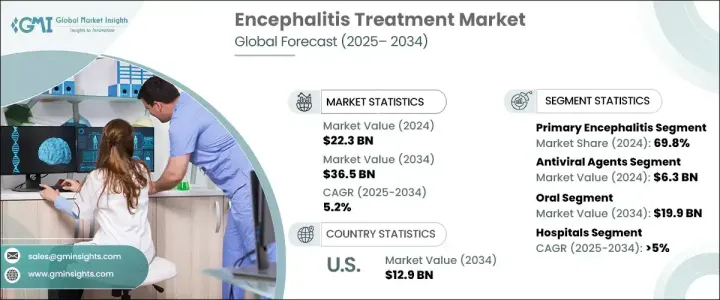
세계 뇌염 치료 시장은 2024년에 223억 달러로 평가되었으며 2025년부터 2034년까지 연평균 복합 성장률(CAGR) 5.2%로 성장할 것으로 예측됩니다.
이 시장은 바이러스 감염의 급증과 환경 변화로 인한 질병을 유발하는 매개체에 대한 노출이 증가함에 따라 뇌염의 사례가 세계적으로 계속 증가함에 따라 꾸준히 확대되는 태세를 갖추고 있습니다. 이 심각한 신경 증상과 진단되는 환자가 증가함에 따라 건강 관리 시스템은 적시에 효과적인 치료 옵션을 제공해야합니다. 벡터가 매개하는 질병의 유병률 상승과 뇌염에 걸리기 쉬운 노인 인구 증가가 결합되어 고급 치료 솔루션에 대한 수요가 가속화되고 있습니다.

또한 차세대 항바이러스제, 면역요법, 진단기술의 도입으로 뇌염 치료의 상황이 더욱 변화하고 있습니다. 건강 관리 제공업체와 제약 회사는 협력하여 급성 염증을 다루는 것뿐만 아니라 장기적인 신경 장애를 예방하는 치료 경로를 혁신하기 위해 노력하고 있습니다. 특히 신흥경제국에서는 조기진단과 조기개입이 중시되고 시장개척에 유리한 환경이 갖추어지고 있습니다. 이와 병행하여 일반시민의 의식이 높아지고 정부 주도의 헬스케어 이니셔티브가 개발도상국 전체에서 보다 나은 치료에 대한 접근을 요구하는 수요를 뒷받침하고 있으며, 뇌염치료가 세계헬스케어에서 중요한 중점 분야가 되고 있습니다.
| 시장 범위 | |
|---|---|
| 시작 연도 | 2024년 |
| 예측 연도 | 2025-2034년 |
| 시작 금액 | 223억 달러 |
| 예측 금액 | 365억 달러 |
| CAGR | 5.2% |
시장은 질병 유형에 따라 1차성 뇌염과 2차성 뇌염의 2가지로 분류됩니다. 바이러스 감염, 특히 모기와 진드기에 의한 감염 발생률이 증가함에 따라 원발성 뇌염 사례가 증가하고 있어 효과적인 치료 솔루션에 대한 큰 수요가 발생하고 있습니다. 항바이러스제는 염증을 억제하고 신경학적 합병증을 경감하기 때문에 이러한 사례의 관리에는 필수적입니다.
치료 유형별로 보면 뇌염 치료 시장에는 항생제, 스테로이드 주사, 면역글로불린 요법, 플라즈마 페레시스, 항바이러스제 및 기타 치료가 포함됩니다. 항바이러스제에 대한 강력한 수요는 주로 전 세계적으로 바이러스성 뇌염 환자 수 증가가 배경에 있습니다. 이 약은 염증을 관리하고 심각한 뇌 손상을 예방하는 효과가 입증되어 있기 때문에 표준 치료 요법의 중요한 부분이되고 있습니다.
미국 뇌염 치료 시장은 2024년에 92.6%의 점유율을 차지하고, 80억 달러 수익을 올렸으며, 2034년에는 129억 달러에 이를 것으로 예측됩니다. 미국의 성장은 질병 인식 제고, 빠른 진단 발전, 혁신적인 치료법의 광범위한 가용성에 의해 주도되고 있습니다. 이 나라의 견고한 헬스케어 인프라와 상당액의 의료비에 의해 환자는 최첨단의 치료법에 액세스할 수 있어 뇌염 치료 분야에서 이 나라의 리더로서의 지위가 강화되고 있습니다.
The Global Encephalitis Treatment Market was valued at USD 22.3 billion in 2024 and is projected to grow at a CAGR of 5.2% during 2025-2034. This market is poised for steady expansion as cases of encephalitis continue to rise worldwide, driven by a surge in viral infections and increasing exposure to disease-causing vectors due to environmental changes. As more individuals are diagnosed with this serious neurological condition, healthcare systems are under growing pressure to provide timely and effective treatment options. The rising prevalence of vector-borne diseases, combined with the growing elderly population more susceptible to encephalitis, is accelerating the demand for advanced therapeutic solutions.

Additionally, the introduction of next-generation antiviral agents, immunotherapies, and improved diagnostic technologies is further reshaping the landscape of encephalitis treatment. Healthcare providers and pharmaceutical companies are working together to innovate treatment pathways that not only address acute inflammation but also prevent long-term neurological damage. The growing emphasis on early diagnosis and intervention, especially in developed economies, is creating a favorable environment for market expansion. Alongside this, increased public awareness and government-led health initiatives are pushing the demand for better treatment accessibility across developing nations, making encephalitis treatment a key focus area in global healthcare.
| Market Scope | |
|---|---|
| Start Year | 2024 |
| Forecast Year | 2025-2034 |
| Start Value | $22.3 Billion |
| Forecast Value | $36.5 Billion |
| CAGR | 5.2% |
The market is segmented into two primary categories based on disease type: primary encephalitis and secondary encephalitis. Primary encephalitis, directly caused by viral infections leading to brain inflammation, dominated the global market in 2024 with a 69.8% share. As incidences of viral infections climb, especially those transmitted by mosquitoes and ticks, primary encephalitis cases are growing, creating significant demand for effective treatment solutions. The availability of antiviral drugs is essential in managing these cases, as they help reduce inflammation and mitigate neurological complications. Moreover, climate change continues to influence the spread of vector-borne diseases, directly impacting the prevalence of primary encephalitis and subsequently driving up the need for therapeutic interventions.
Based on treatment type, the encephalitis treatment market includes antibiotics, steroid injections, immunoglobulin therapy, plasmapheresis, antiviral agents, and other therapies. Among these, antiviral agents generated USD 6.3 billion in 2024, emerging as a dominant segment. The strong demand for antiviral medications is primarily fueled by the rising number of viral encephalitis cases worldwide. These drugs have become a critical part of standard treatment regimens due to their proven efficacy in managing inflammation and preventing serious brain damage. Increasing research and development efforts toward novel antiviral compounds, along with supportive government initiatives and enhanced diagnostic tools, are expected to strengthen this segment's growth trajectory over the next decade.
The United States Encephalitis Treatment Market accounted for a substantial 92.6% share in 2024, generating USD 8 billion, and is forecasted to reach USD 12.9 billion by 2034. Growth in the U.S. is driven by heightened disease awareness, rapid diagnostic advancements, and widespread availability of innovative treatments. The country's robust healthcare infrastructure, coupled with significant healthcare spending, ensures that patients have access to cutting-edge therapies, reinforcing the nation's position as a leader in the encephalitis treatment space.